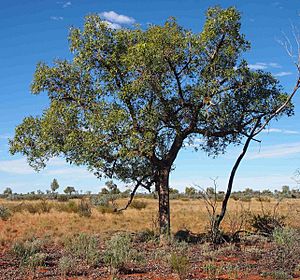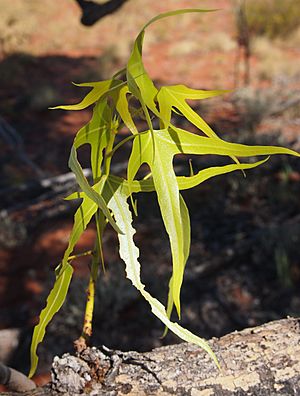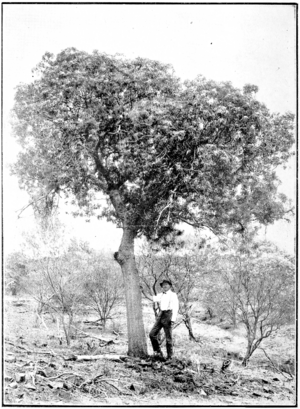Desert kurrajong facts for kids
Quick facts for kids Desert kurrajong |
|
|---|---|
 |
|
| Scientific classification | |
| Genus: |
Brachychiton
|
| Species: |
gregorii
|
The Brachychiton gregorii, often called the desert kurrajong, is a small tree. You can find it growing in the dry areas of northern and western Australia. This tree belongs to the Brachychiton group. It was once part of the Sterculiaceae plant family. Now, scientists place it within the Malvaceae family, which includes plants like mallows.
Contents
Understanding the Desert Kurrajong's Name
How Scientists Name Plants
Scientists give every plant a special two-part name. This helps everyone know exactly which plant they are talking about. The desert kurrajong's scientific name, Brachychiton gregorii, was first officially described in 1862. A botanist named Ferdinand von Mueller did this work. He was a very important plant scientist.
Who Was Augustus Charles Gregory?
The second part of the tree's name, gregorii, honors a famous explorer. His name was Augustus Charles Gregory. He later became a surveyor-general, mapping out land. So, the tree is named after him to remember his contributions.
What Does the Desert Kurrajong Look Like?
Size and Shape of the Tree
This tree usually grows to be about 3 to 12 meters (10 to 39 feet) tall. Its branches spread out, creating a canopy about 2 to 5 meters (7 to 16 feet) wide. It's an evergreen tree, meaning it usually keeps its leaves all year.
Leaves, Flowers, and Fruit
The leaves of the desert kurrajong can grow up to 20 centimeters (8 inches) long. They often have three or five pointed parts, like fingers on a hand. These leaves are attached to a long stalk. During very dry times, the tree might shed its leaves.
The tree blooms between October and December. It produces groups of flowers called inflorescences. These flowers are bell-shaped and usually pale yellow. They often have a reddish edge, making them quite pretty. After the flowers, black, woody seed pods grow. These pods can be up to 5 centimeters (2 inches) long. Inside, they hold many seeds, ready to grow new trees.
Where Does the Desert Kurrajong Grow?
Its Home in Australia
The desert kurrajong is found in scattered spots across Australia's dry regions. You can see it in the northwestern part of South Australia. Here, it likes to grow on rocky ridges, slopes, and sand dunes.
It also lives in the Northern Territory. In Western Australia, you can find it in the Goldfields, Pilbara, and Mid West areas. It prefers red sandy or loamy soils in these places.
How Does the Desert Kurrajong Live with Other Plants and Animals?
Living Near Granite Rocks
This tree often grows close to the large granite rock formations in Western Australia. These rocks create special environments where the tree can thrive.
A Tree and Its Guests
Sometimes, a plant called mistletoe grows on the desert kurrajong. This mistletoe, named Amyema benthamii, is a parasite. This means it lives on the kurrajong tree and takes some of its nutrients. Birds help spread mistletoe seeds by leaving them on branches. Later, a type of caterpillar, which is the young form of the moth Comocrus behri, eats this mistletoe. It's like a small food chain happening right on the tree!
What Are the Uses of the Desert Kurrajong?
Growing and Caring for the Tree
The desert kurrajong is sold for planting. You can buy its seeds or young trees. It's a great choice for dry areas because it can handle drought very well once it's grown. It also doesn't mind a little frost. This tree can grow in full sun or partial shade, as long as the soil drains water well. When it's young, it forms a large, swollen root called a tuber. Because of this, some people even grow it as a small, artistic plant called a succulent bonsai.
Other Uses of the Tree
The wood of the desert kurrajong is soft and spongy. This makes it useful for making wood pulp, which is used to create paper. The tree doesn't grow very tall, but it has many branches. This creates a thick top, or crown, that gives excellent shade. People can also get a strong fiber from the tree's inner bark, called the cambium layer.
See also
 In Spanish: Brachychiton gregorii para niños
In Spanish: Brachychiton gregorii para niños




